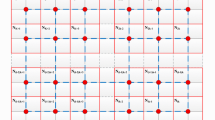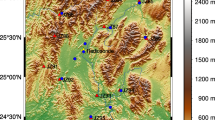Abstract
The importance of water vapor in research of global climate change and weather forecast cannot be over emphasized; therefore substantial efforts have been made in exploring the optimal methods to measure water vapor. It is well-established that with a conversion factor, zenith wet delays can be mapped onto precipitable water vapor (PWV). However, the determination of the exact conversion factor depends heavily on the accurate calculation of a key variable, weighted mean temperature of the troposphere (T m). As a critical parameter in Global Positioning System (GPS) meteorology, T m has recently been modeled into a global grid known as GWMT. The GWMT model only requires the location and the day of year to calculate T m. Despite the advantages that the GWMT model offers, anomalies still exist in oceanic areas due to low sampling resolution. In this study, we refine the GWMT model by incorporating the global T m grid from Global Geodetic Observing System (GGOS) and obtain an improved model, GWMT-G. The results indicate that the GWMT-G model successfully addresses the anomaly in oceanic areas in the GWMT model and significantly improves the accuracy of T m in other regions.
Similar content being viewed by others
References
Askne J, Nordius H. 1987. Estimation of tropospheric delay for mircowaves from surface weather data. Radio Sci, 22: 379–386
Bevis M, Businger S, Herring A T, et al. 1992. GPS meteorology: Remote sensing of atmospheric water vapor using the global positioning system. J Geophys Res, 97: 15787–15801
Bevis M, Businger S, Chiswell S et al. 1994. GPS meteorology: Map-ping zenith wet delays onto precipitable water. J Appl Meteorol, 33: 379–386
Boehm J, Heinkelmann R, Schuh H. 2007. Short Note: A global model of pressure and temperature for geodetic applications. J Geod, 81: 679–683
Byun S H, Bar-Sever Y E. 2009. A new type of troposphere zenith path delay product of the international GNSS service. J Geod, 83: 1–7
Chen J Y. 1998. On the error analysis for the remote sensing of atmospheric water vapor by ground based GPS. Acta Geod Cartogr Sin, 27: 113–118
Ding J C. 2009. GPS Meteorology and Its Applications. Beijing: China Meteorological Press. 1–10
Duan J, Bevis M, Fang P, et al. 1996. GPS meteorology: Direct estimation of the absolute value of precipitable water. J Appl Meteorol, 35: 830–838
Gu X P. 2004. Research on retrieval of GPS water vapor and method of rainfall forecast. Doctoral Dissertation. Beijing: China Agricultural University. 1–15
Li J G, Mao J T, Li C C. 1999. The approach to remote sensing of water vapor based on GPS and linear regression T m in eastern region of China. Acta Meteorol Sin, 57: 283–292
Rocken C, Ware R, Van Hove T, et al. 1993. Sensing atmospheric water vapor with the global positioning system. Geophys Res Lett, 20: 2631–2634
Ross R J, Rosenfeld S. 1997. Estimating mean weighted temperature of the atmosphere for Global Positioning System. J Geophys Res, 102: 21719–21730
Saastamoinen J. 1972. Atmospheric correction for the troposphere and stratosphere in radio ranging satellites. In: Soren W. Henriksen, Armando Mancini, Bernard H. Chovitz, eds. The Use of Artificial Satellites for Geodesy, Geophysics Monograph Series, Vol. 15. Washington DC: American Geophysical Union. 247–251
Xu C Q, Shi J B, Guo J M, et al. 2011. Analysis of combining ground-based GPS network and space-based COSMIC occultation observation for precipitable water vapor application within China. Geomat Inf Sci Wuhan Univ, 36: 467–470
Yao Y, Zhu S, Yue S. 2012. A globally applicable, season-specific model for estimating the weighted mean temperature of the atmosphere. J Geod, 86: 1125–1135
Yu S J. 2011. Remote sensing of water vapor based on ground GPS observations. Doctoral Dissertation. Wuhan: Institute of Geodesy and Geophysics, Chinese Academy of Sciences. 37–50
Author information
Authors and Affiliations
Corresponding author
Rights and permissions
About this article
Cite this article
Yao, Y., Xu, C., Zhang, B. et al. A global empirical model for mapping zenith wet delays onto precipitable water vapor using GGOS Atmosphere data. Sci. China Earth Sci. 58, 1361–1369 (2015). https://doi.org/10.1007/s11430-014-5025-y
Received:
Accepted:
Published:
Issue Date:
DOI: https://doi.org/10.1007/s11430-014-5025-y




